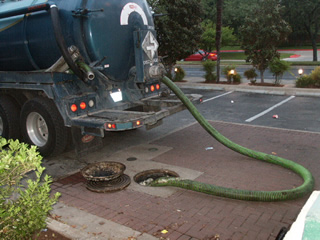Nine dos and don'ts for hiring a grease trap pumping contractor
- Aug 18, 2015
Business managers might feel as if their lives revolve around quarters … quarters of the year, that is. From taxes to financial reports and marketing initiatives, managers have a laundry list of tasks to accomplish four times a year. Food service establishment operators have yet one more responsibility to tackle at least once a quarter — the pumping of the grease trap.
Granted, most restaurant and commercial kitchens contract out this dreaded deed, but the manager still must choose a trusted contractor. Working with someone that cuts corners or is frequently tardy could land FSE operators in hot water with their municipalities.
Why so often?

Traditional concrete interceptors range in size from 700 or so gallons to several thousand. Though there are a few different designs, they all rely on the same principle — gravity. Wastewater from a commercial kitchen flows down through the tank, where food particles sink to the bottom and oil rises to the top. The grease-free water in the middle then exits the tank and enters the public sewage lines.
Because the middle layer of water is what exits the tank, installing a properly sized interceptor — and regular maintenance to ensure the grease and water levels are at appropriate levels — are of utmost importance.
To maintain an efficient grease trap, consistent maintenance is key. Though some municipalities dictate otherwise, traditional, underground grease traps should be pumped out every three months or when they reach 25 percent capacity, whatever comes first.
New super-capacity interceptors, like Thermaco’s Trapzilla, on the other hand, can be pumped much less often. Trapzilla, for example, can trap upwards of 90 percent of its total volume and can hold up to 1,826 pounds of fats, oil and grease in just a little over two square yards.
Regardless of the type of interceptor, food service operators should pay heed to the recommended pumping schedule associated with their grease trap. If not regularly pumped, the facility runs the risk of clogs, releasing toxic waste into the public sewage lines, overflowing the trap or sending back-ups into the kitchen itself — or all of the above. Either way, hefty fines and costly repairs result.
The dos and don’ts of hiring a contractor
Do ask questions. Find out how a contractor sets up an ongoing maintenance schedule, how the company handles emergency calls, the history of business, etc.
Don’t go with the first contractor who provides a quote. Shop around! Getting quotes from at least three contractors will ensure you secure the best prices. After all, this is a quarterly expense that will hit the restaurant’s pocketbook as long as you’re in business! Make sure it’s reasonable.
Do research! Find out where the company disposes of their waste. There was a case of a company operating under the Roto Rooter name in Alabama that disposed its waste directly into the municipal sewer system.
Do get recommendations. Talk to your local water treatment authority, as well as other establishments in the area.
Do check for companies that have a grease-recycling program. Although the brown grease collected from grease traps isn’t suitable for use without refinement, many pump contractors have standing relationships with biodiesel production companies.
Don’t schedule pump truck visits while FSE operator can’t be present. Not only do vigilant eyes prevent contractors from cutting corners, but it also allows management to respond to, and ask, questions.
Do give the well a once-over after the contractor performs his services. There should be no caked grease in the corners or on the walls, and the trap should be completely empty. Trapzilla Grease Interceptors have rounded walls and a conical bottom to prevent grease and solids from building up in corners and decreasing its efficiency.
Do ask your contractor to help educate your kitchen staff. Good contractors should be able to help your employees identify sources of grease and potentially find ways to decrease the amount of grease going into the trap.
Do look for a contractor that can also handle other plumbing maintenance and repairs that may occasionally arise. Bonus points if the contractor can handle grease trap replacement down the road!
Not only should a contractor help you establish a proactive, efficient pretreatment program, but the firm should also follow up with you in between services to ensure things are going smoothly. It’s important to remember that a proper maintenance program means more than pumping the tank and jetting the lines once a quarter!
Look for a contractor that will help you develop a program that will eventually lead to shorter, more efficient quarterly visits. A good contractor should provide you with a program that will reduce the amount of work required to keep your trap operating smoothly and reduce your annual maintenance cost.






